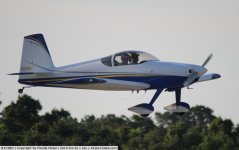Draker
Well Known Member
FAR 45.25:
It seems like a safe assumption that the rudder counts as a "vertical tail surface". I ask because I've been looking at a lot of paint schemes for inspiration and I don't recall ever seeing an N number on a rudder! Many on the vertical stabilizer.
(a) The operator of a fixed-wing aircraft must display the required marks on either the vertical tail surfaces or the sides of the fuselage, except as provided in § 45.29(f).
(b) The marks required by paragraph (a) of this section must be displayed as follows:
(1) If displayed on the vertical tail surfaces, horizontally on both surfaces, horizontally on both surfaces of a single vertical tail or on the outer surfaces of a multivertical tail. However, on aircraft on which marks at least 3 inches high may be displayed in accordance with § 45.29(b)(1), the marks may be displayed vertically on the vertical tail surfaces.
It seems like a safe assumption that the rudder counts as a "vertical tail surface". I ask because I've been looking at a lot of paint schemes for inspiration and I don't recall ever seeing an N number on a rudder! Many on the vertical stabilizer.












